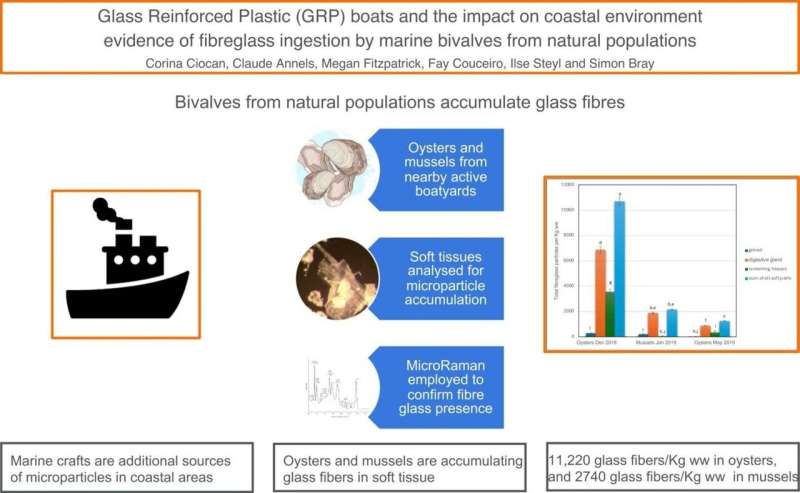This article has been reviewed according to Science X's editorial process and policies. Editors have highlighted the following attributes while ensuring the content's credibility:
fact-checked
peer-reviewed publication
trusted source
proofread
Study reveals worrying levels of fiberglass in oysters and mussels

A new study has revealed worrying levels of fiberglass in oysters and mussels. This marks the first time fiberglass or glass reinforced plastic (GRP) particles have been found entering the food chain and raises urgent environmental and health concerns.
The study, published in the Journal of Hazardous Materials, a collaborative effort from the Universities of Brighton and Portsmouth, showed that GRP, which is used extensively in boat manufacturing, is breaking down and contaminating coastal waters.
This material, once thought to be durable and beneficial, is now causing unexpected harm to marine life.
The GRP particles have been detected in the soft tissues of oysters and mussels collected near an active boatyard in Chichester Harbor, a popular sailing destination in South England. Using micro Raman spectroscopy, researchers found up to 11,220 fiberglass particles per kilogram in oysters and 2,740 particles per kilogram in mussels.
Dr. Corina Ciocan, principal lecturer in marine biology from the University of Brighton, said, "Our findings show a disturbing level of GRP contamination in marine life. This study is the first of its kind to document such extensive contamination in natural bivalve populations. It's a stark reminder of the hidden dangers in our environment."
Fiberglass, widely used since the 1960s in boat manufacturing, is notorious for its durability. However, it's also incredibly difficult to dispose of properly, often ending up abandoned or improperly discarded.
This results in tiny glass particles entering the water, especially during peak boat maintenance seasons like winter. These particles then accumulate in bivalves such as oysters and mussels, which are crucial to marine ecosystems due to their filter-feeding habits.
The study highlights the risks associated with GRP contamination. Bivalves, being stationary filter feeders, are highly susceptible to accumulating these particles, which can severely impact their health. The ingestion of GRP can interfere with their digestive systems, leading to physiological stress and even death.
This not only affects marine life but could also have significant implications for human health, given that these bivalves often end up on our plates.
Professor Fay Couceiro from the University of Portsmouth said, "It's a global issue, particularly for island nations with limited landfill space. Efforts are being made to find viable disposal solutions, but more needs to be done to prevent at-sea dumping and onshore burning.
"We're just starting to understand the extent of fiberglass contamination. Our study is the first to show this level of contamination in natural bivalve populations."
The consequences of this contamination are not yet fully understood, but the potential for widespread ecological impact is significant. The study is advocating for further research to understand the potential transfer up the food chain and the implications for human health.
The research highlights the urgent need for better regulation and management of GRP disposal. Dr. Ciocan said, "We must improve public access to slipways and commercial boat maintenance facilities. Creating a better ethos around end-of-life boat management is crucial to minimize further exposure and spread of these contaminants."
For now, the discovery serves as a wake-up call to the boating community and environmental regulators. Professor Couceiro said, "We have to address this issue head-on to protect our marine ecosystems and ensure a healthier future for our oceans."
More information: Corina Ciocan et al, Glass reinforced plastic (GRP) boats and the impact on coastal environment – Evidence of fibreglass ingestion by marine bivalves from natural populations, Journal of Hazardous Materials (2024). DOI: 10.1016/j.jhazmat.2024.134619
Journal information: Journal of Hazardous Materials
Provided by University of Portsmouth



















